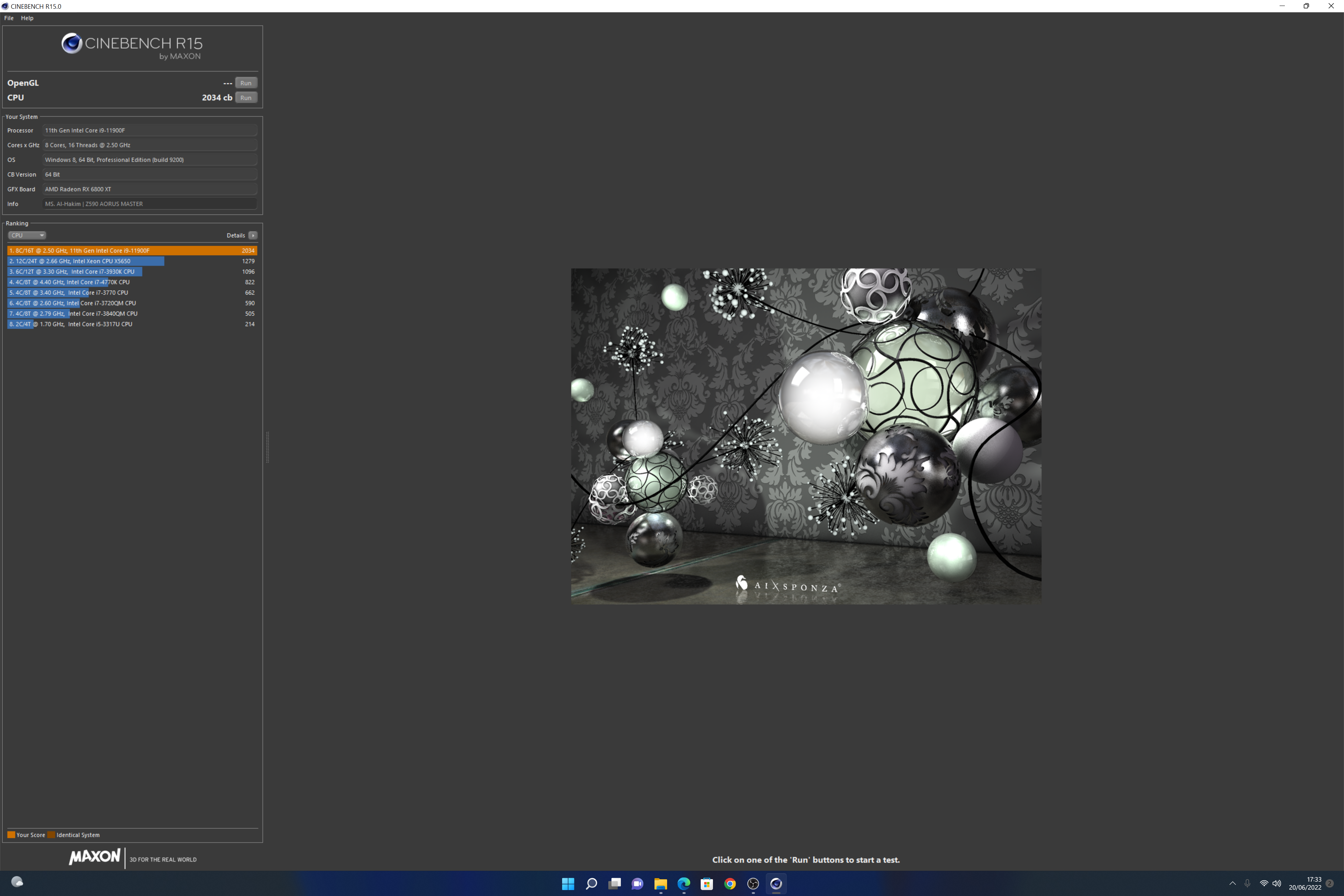Cinebench - R15 score 2034 cb with a i9-11900F
Thursday, 01 January 1970 07:00 | Update at null
Media Gallery
Screenshot

Device, Setup, etc
URL
https://hwbot.org/submission/5023779https://www.facebook.com/photo/?fbid=3315102848722355&set=a.1640487006183956
Information Detail
Hardware: Intel Core i9 11900F
Specs:CPUID : 11th Gen Intel(R) Core(TM) i9-11900F @ 2.50GHz
Architecture : x86
Codename : Rocket Lake
L3 Cache : 8MB
Clock : 2.5GHz - 5.2GHz
Core/Thread : 8/16
TDP : 65W
Technology : 14nm
Socket : LGA1200
IGPU : -
See more specification...
Software: Cinebench - R15
Score: 2034 cb
About: Cinebench - R15Cinebench R15 is one of the most popular CPU and GPU benchmarks developed by Maxon, the creator of CINEMA 4D software. Released at a time when quad-core processors were becoming commonplace, Cinebench R15 quickly became the standard tool for measuring the rendering performance of various types of desktop and laptop processors. This benchmark simulates the process of rendering photorealistic 3D graphics using the CINEMA 4D engine and assigns a score based on how quickly the CPU can complete the task.
In multi-core testing, Cinebench R15 utilizes all available threads and cores on the processor to render a complex scene consisting of over 300,000 polygons. This scene includes area lighting, soft shadows, sharp and blurry reflections, procedural textures, and anti-aliasing. All these elements are designed to place high stress on the entire CPU processing system, creating an environment that closely resembles real-world scenarios in digital content production or professional rendering.
Cinebench R15 scores are measured in “points” (pts), where higher numbers indicate better performance. This benchmark is ideal for evaluating rendering capabilities, multitasking performance, and overall processor efficiency, especially in applications that utilize multiple cores, such as Blender, Adobe Premiere, or CAD software.
Although Cinebench R15 has been replaced by newer versions like R20 and R23, Cinebench R15 is still widely used today due to its broad compatibility, lightweight execution, and consistent results. Especially for reviewers and users looking to compare processors across generations, R15 remains an important benchmark in the world of hardware and PC enthusiasts.
The Intel Core i9-11900F, launched in 2021, is a high-end desktop processor from the 11th generation Rocket Lake family. Featuring 8 cores and 16 threads, this CPU is built for users who demand strong single-core performance in tasks such as gaming, creative workloads, and professional applications. With a base clock speed of 2.5 GHz and a boost clock up to 5.2 GHz via Intel Turbo Boost Max Technology 3.0, the i9-11900F delivers fast responsiveness and excellent performance in lightly threaded scenarios.
Manufactured on the 14nm process, the i9-11900F introduces architectural improvements over its predecessor, including a significant IPC (Instructions Per Cycle) gain, thanks to the new Cypress Cove core design. However, despite these gains, the reliance on the older 14nm node leads to higher power consumption and lower efficiency compared to AMD’s Ryzen 5000 series built on 7nm technology—especially in sustained multi-threaded workloads.
As an “F” series processor, the i9-11900F lacks integrated graphics, meaning it requires a dedicated GPU to operate. This makes it a better fit for gaming PCs or professional workstations that already include a discrete graphics card. While this may not be ideal for users seeking basic systems without a GPU, it allows Intel to price the CPU more competitively.
In benchmarks and real-world performance tests, the Core i9-11900F excels in gaming, offering frame rates comparable to top-tier CPUs when paired with a modern graphics card. It also performs well in productivity tasks such as photo editing, software development, and video rendering—though users working with highly threaded applications might benefit more from CPUs with higher core counts.
Overall, the Intel Core i9-11900F is a solid choice for enthusiast builders, gamers, and users looking for top-tier single-core performance, but it may not be the most efficient option for heavy multitasking or rendering workloads when compared to newer multi-core CPUs.
* Not Avaiable
